Description
The Ford Cougar II was a striking concept car revealed in 1963, created during a period when Ford’s design studios were exploring sleek, futuristic shapes inspired by European grand tourers. Unlike some of Ford’s more radical show cars of the era, the Cougar II was presented as a near-production-ready design study, showcasing what could have been a high-performance two-seat sports car to rival the Chevrolet Corvette and contemporary European exotics.
From the outside, the Cougar II was an elegant fastback coupe with proportions and styling cues reminiscent of Ferraris and Jaguars of the time. Its long hood, short rear deck, and flowing fastback roofline gave it a purposeful and athletic look. The front featured a low, pointed nose with pop-up headlights that gave it a clean and aerodynamic appearance, while the sides were smooth and unadorned, emphasizing sculpted curves over chrome trim. The rear end sloped gently, with simple tail lamps integrated into the bodywork. Finished in a vivid red metallic paint, the Cougar II looked every bit the part of an Italian-style sports car, though it carried Ford’s distinctly American design language.
The interior was equally refined, with bucket seats trimmed in leather and a driver-focused dashboard featuring a full set of gauges. The cabin design aimed to match the sophistication of European grand tourers, with attention given to materials and detail rather than the spartan simplicity found in many concept cars. This lent the Cougar II a sense of plausibility, as though it could have easily gone into limited production.
Underneath, the Cougar II was reported to be built around a Shelby Cobra chassis, reinforcing its connection to Ford’s growing performance ambitions. Power likely would have come from a small-block Ford V8, possibly the 260 or 289 cubic inch engines, both of which were lightweight yet potent choices for a two-seat sports car. With such a setup, the Cougar II would have had the performance credentials to match its exotic looks. Independent suspension and lightweight construction would have further enhanced its handling, making it a credible competitor to the Corvette or European rivals had it been produced.
The Cougar II was shown on the auto show circuit in 1963 alongside other experimental Fords, including the Allegro concept and the first Mustang I prototype. Unlike those vehicles, however, it was positioned less as a preview of a production car and more as a demonstration of Ford’s design and engineering capabilities in the high-performance sports car realm. Its reception was positive, with many observers noting its Ferrari-like appearance and wondering if Ford would challenge General Motors’ Corvette directly.
Ultimately, the Cougar II never moved beyond the concept stage. Ford was already deeply committed to launching the Mustang as a mass-market sporty car, and the GT40 program was in development as the company’s racing flagship. There was little room in the lineup for a limited-production exotic coupe, no matter how striking. The Cougar name itself would later be repurposed for Mercury’s sporty pony car in 1967, tying it instead to the Mustang rather than to a European-inspired grand tourer.
Today, the Ford Cougar II survives as one of the most memorable and beautiful of Ford’s early 1960s dream cars. It is admired for its elegant proportions, its connection to the Shelby Cobra chassis, and the glimpse it offered into a world where Ford might have built a rival to Ferrari and Corvette for the street. Preserved in Ford’s concept collection, it stands as a testament to the company’s creative energy and ambition at a time when performance and style were reshaping the American automotive landscape.
